Field Day Recap: Livestock Integration on a Small-Scale Vegetable Farm
Kelly Clime of Hoof Beet Farm started her venture of farming 2016 by purchasing a 3.5-acre farm near Dallas Center. Kelly has a unique diversely integrated farm with chickens, turkeys, vegetables, and an apiary. All of which is draft powered by her Quarter Horse/Shetland pony. All the different pieces of the farm have a significant part in working together to support the farm. Kelly is a beginning farmer and is in her second year of the Savings Incentive Program (SIP). She shared her experience with 28 attendees at the field day last week on how she is working with her livestock to renovate her pasture and support vegetable production. Kelly covered her steps for on-farm poultry processing, approaches of direct marketing, beekeeping, farm insurance, and her use of the draft pony. Kelly’s goal for her farm is to be as diverse as possible, by integrating everything. She says, “sustainability is built with diversity.”
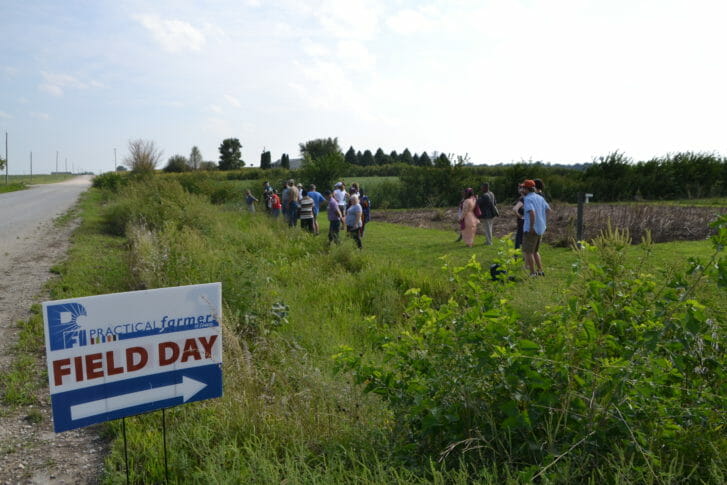
Kelly Clime led field day attendees through the farm explaining how she integrates chickens, honey bees, and draft horses at Hoof Beet Farm
Pastured Broilers
When Kelly first moved to her farm in 2013 the land had a lot of trash and debris, her chickens have helped to fertilize and renovate the horse pasture. Kelly raises four batches of broilers each year, with about 20 birds in each batch totaling to about 80 birds a year. One of the things that allows her to process on-farm the USDA state processing meat processing regulation exemption, which allows her to process up to 1,000 birds a year. This exemption allows Kelly to sell directly to the customers.
Kelly’s broilers are kept on pasture in a woody area of her farm within an electric fence. She self-designed a hooped structured shelter on a 2×4 base with three cattle panels hooped between the skids. Having the birds out in a woody area, predators like owls are can be an issue, but since Kelly has been utilizing this structure she hasn’t had too much trouble with predation lately.
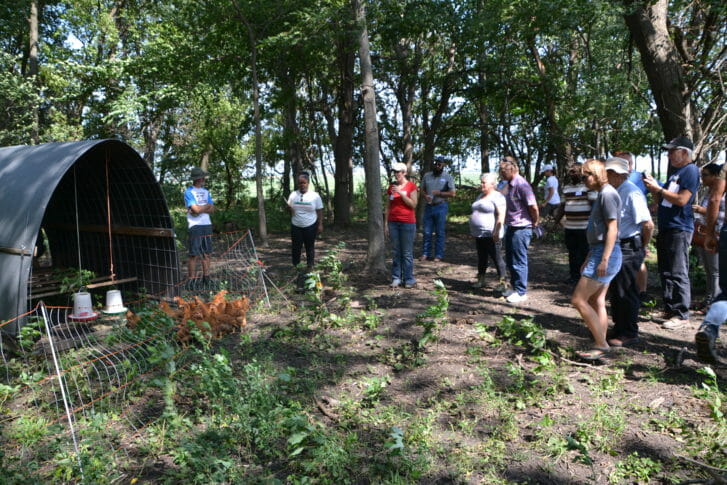
Kelly, showing us her broilers and the hoop structure she’s constructed.
On-Farm Poultry Processing
Four birds were processed for a live demonstration, Kelly went first to highlight the steps she takes, and then called upon three other volunteers to follow along by hands-on instruction. Kelly advises to fast the birds for about 12 hours before processing them. Kelly processes first thing in the morning, stopping their feed the night before. Even though the birds are off feed, it is important to keep them on water. Kelly says, “You don’t want the birds getting dehydrated, because that causes internal issues when processing. Fasting the birds helps to not have a full crop, which minimizes contamination to the meat when cutting up the bird.”
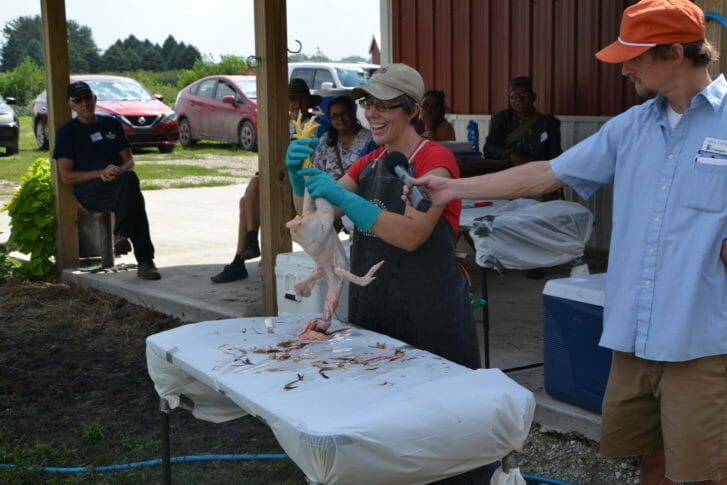
Kelly demonstrating how to pin off feathers of a chicken.
Livestock Integration and the Vegetable Garden
On Hoof Beet Farm the livestock are deeply integrated into the farm. Kelly states, “the vegetables started everything, and the farm just grew from there with broilers, then layers, and now turkeys.” Kelly’s philosophy is that, “if it’s going to be here it’s going to work, work for me and work together.” Together they make up the products she markets directly to her customers through a farmer’s market stand and CSA subscriptions.
Red Irish, a 24-year-old Quarter horse/Shetland pony is the primary source of power for the farm. Luckily, Red Irish was already broke to drive, and it was just a matter of figuring out where and how Kelly could use him. She is able to scale the amount of work to a horse his size, “things like the cultivator with a horse his size I am able to get 18” row spacing,” says Kelly. Since her draft pony is close to retirement age, Kelly is thinking of replacing the pony with a team of oxen. “I used to work at the Living History Farms and has some experience with using draft cattle and horses. Starting with calves, training them until their full-grown is an advantage to begin training them much earlier than you would with a horse, “says Kelly.
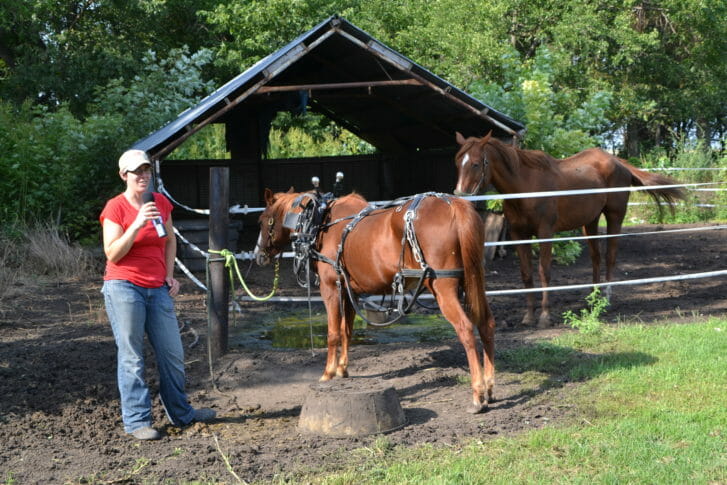
Kelly showcases her draft pony Red Irish and the material of his reigns, and Max her other horse in the paddock.
Honey Bees
Kelly shared that growing her apiary has been one of her top goals to help increase pollination on the farm and diversify sales with small-batch honey. She learned how to keep bees by taking a class at Cherry Glen Learning Farm in Polk City. Now, she is involved with the Friendly Bee Keepers of Iowa club. “I have one hive, and was able to get just about 30 lbs. of honey harvested. This is my second year keeping bees,” says Kelly “last year we had a hive that did not survive the winter so we are hoping this year they will make it through.”
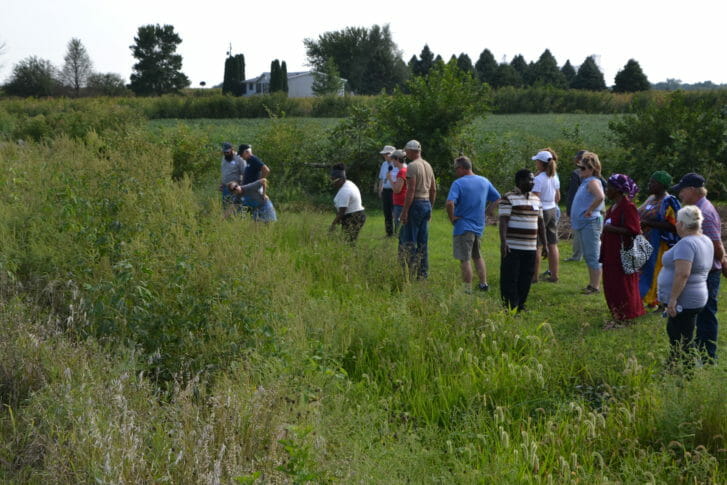
Kelly shows the different pollinators she has growing in a roadside ditch
In an effort to increase native pollinators, Kelly conducted a roadside pollinator project in partnership with People for Pollinators Program from the Neal Smith Wildlife Refuge. The pollinator project helps the bees provide great pollination for the vegetables and the fruit trees Kelly has. “They can help you start prairie areas, and bring you seedlings to plant. We planted 750 prairie seedlings in part of our ditch last spring, and had a really nice bloom from them this year even though they flooded just a bit, they bounced back,” says Kelly. The seedlings they planted last year were a mix of side oats, hoary vervain, little bluestem, milkweed, black-eyed susan’s, several grasses, and grey honeycomb coneflower.
Pastured Layers
For Kelly, her laying hens are the last piece of the whole livestock integration system. Kelly mentions that, “nine months out of the year when we don’t have vegetables growing in the garden we are able to free-range them, moving fences around to redirect them to the garden so they do a lot of the fall control on the garden. The hens consume all the bugs and weed seed, which decreases the amount of weed pressure on the following growing season.”
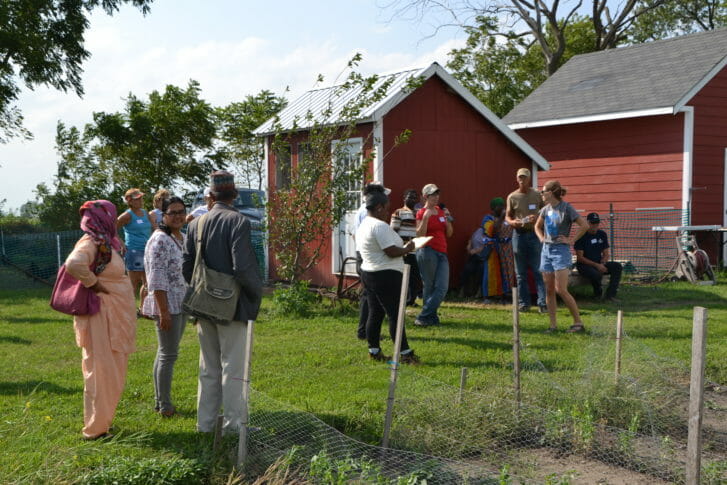
Kelly explains her vegetable garden integrates with the laying hens and honey bees.
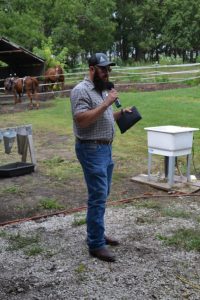
Mark Guiterrez, a Deputy Director at USDA Risk Management Agency mentioned, “The more commodities you have (three or more); you get a premium discount because you are considered less risky.”
Farm Insurance
Mark Gutierrez from the USDA – Risk Management Agency (RMA) attended the field day to share information about farm insurance programs for both crops and livestock.
Mark explained, “The USDA regulates and oversees, writes the policy, sets the rates, determines where the coverage is going to be, comes up with the plans to protect producers, and services and delivered by private industry by private companies with crop insurance and adjusters. USDA doesn’t sell the insurance, but run the program that helps provide the service to farmers.” He continued to share how, “from the 2014 Farm Bill, the whole farm revenue protection insurance, uses your tax forms to determine a five-year average revenue and that is where you are going to be insurance at, then you can pick a coverage level from there.” If you are wanting more information and resources on how farm insurance and business planning, check out PFI’s page on Risk Management and Farm Financial Planning.
Direct Marketing
For Kelly, developing a personal relationship between her and customers is a significant value for her farm and market establishment. Her CSA started small with six members, last year was her biggest year with 15 members, and she is now back down to seven members which is more comfortable for her to manage as the only person doing the farming plus holding a part-time off-farm job.
In the winter months, Kelly spends a lot of the time getting the word out, telling people that she raises chickens and produces vegetables. “Word of mouth has helped a lot, I have customers who put in orders and they tell their friends. Selling in bulk has helped also. Letting my customers know that I process four times a year, and then they have to pick up these four times a lot of customers are ordering five birds for each of those pick-ups. I try to sell in bulk as much as I can. I will also go to local farmers markets, and talk to folks there about my farm about what I raise and sell.”
When it comes to marketing her honey, “I try to set myself apart by calling my product small batch honey. Compared too much larger commercialized honey production systems that have major extractions. I have one hive, with one harvest. Every honey harvest is created with different with floral varieties, developing a different flavor profile so customers who appreciate that will appreciate the individuality of having a smaller batch of honey,” says Kelly.
Her plans are to keep the CSA small, “I do want to keep doing it because my members are great and we have developed a strong relationship of working together. I do not think I will go above ten members. If I do end up having surplus, I use the farmers market to sell any extra produce,” Kelly mentions.
If you would like to learn, more about CSAs and marketing check out these Farminars below:
Thank you to Kelly for opening up her farm!
